Tag Archive: Medical
August 3, 2020
by Carole Zangari -
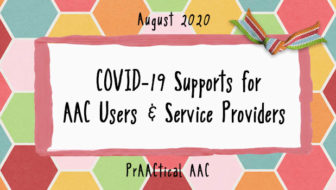
“I need to prepare my child for nasal swab testing.” “How can I get my students to wear their masks?” “My students don’t wash their hands properly.” “What vocabulary and messages should I add to SGDs for my students to be able to talk about the coronavirus?” “How can I explain social distancing in ways that make sense?” “What can I do to help my students know what to expect from a Zoom session?” If you have questions like these, take some time to browse through this online resource list with over 150 free downloads, videos, and more. We’ve updated this resource quite a bit since it was first published 4 months ago and are re-publishing it for those who need visual supports, social stories, videos, and communication boards. In the online newsletter below, you can access visual schedules for handwashing, social narratives, videos, educational materials, and more by clicking... [Read More...]
Filed under: Featured Posts, PrAACtical Thinking
Tagged With: Current Events & Social Issues, downloads, Health, hospital, Medical
December 7, 2016
by Carole Zangari -
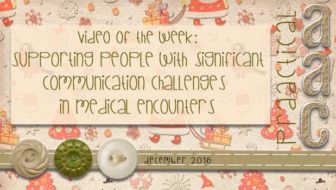
Encounters with healthcare providers can range from the mundane (e.g., getting a prescription filled) and routine (e.g., doctor’s appointment) to situations which are more complicated and urgent (e.g., Emergency Room visit, hospital stay). People who use AAC are part of a larger group of individuals whose communication challenges make these situations more complex. In today’s featured video, Dr. David Beukelman discusses ways in which effective communication between patients with communication challenges and their healthcare providers can be supported. This video was part of the USSAAC webinar series, which is made possible through the support of ISAAC. Many thanks to those organizations and the Patient Provider Communication organization whose free resources and information are shared in the presentation. Please consider joining and supporting these organizations so that they can continue to serve the AAC community with information, advocacy, and resources like these. Direct Link to Video – https://www.youtube.com/watch?v=Uxd-hWODfm8
Filed under: Video of the Week
Tagged With: advocacy, healthcare, Medical
October 17, 2014
by Carole Zangari -
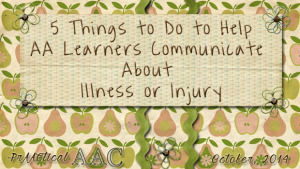
“I don’t want to go now. I’m tired.” “Can you be quiet? I don’t feel well.” “My ear is throbbing.” “I have a such a headache.” “Don’t take me in the car. My stomach’s upset.” Imagine not being able to manage these symptoms or even say these things to get someone to help you. Good SLPs get input from families during the goal-setting process. Often, families indicate that they want their son/daughter to be able to let them know when they are sick or in pain. This makes sense, of course, but it isn’t an easy skill set to build. Here are some things that have worked for us. Make sure the right vocabulary is there: Body parts, feelings, words related to injury or illness, modifiers to tell how much, locatives to tell where. How can we expect AAC learners to communicate when they are unwell if we don’t provide... [Read More...]
Filed under: PrAACtical Thinking
Tagged With: Health, illness, Injury, Medical
February 11, 2014
by Carole Zangari -
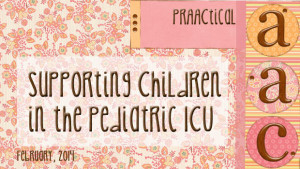
If there is anything scarier than having a very sick child in the ICU, it has to be when that child has no means of communication. In this Research Tuesday post, we join the efforts spearheaded by Rachel Wynn of Gray Matter Therapy to share an article that discusses the issues and presents some solution strategies. When we think of research studies in SLP, we think of experimental designs and randomized controlled trials (RCTs). In AAC, group research designs are uncommon because of the immense heterogeneity of this clinical population. Even limiting the study to one single disorder and age group, say teenagers with dysarthria secondary to cerebral palsy, contains too much heterogeneity for most group research. Instead, we see more single subject design experimental studies (SSEDs) in AAC. When well-designed, SSEDs have strong experimental control and allow researchers to answer causal questions, such as “did the treatment (e.g., teaching... [Read More...]
Filed under: PrAACtical Thinking
Tagged With: Boston Children's Hospital, communication vulnerable, healthcare, hospital, John Costello, Medical, Research Tuesday
January 8, 2014
by Carole Zangari -
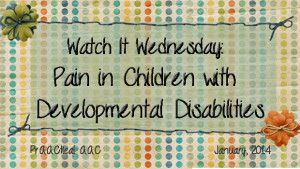
Frustration. Fear. Helplessness. Being with a child in pain is an awful experience no matter what the circumstances. When a child has communication difficulties, the problems are magnified. In this video, we go to the Canadian Association of Paediatric Health Centres for an informative discussion about pain in children with developmental disabilities. Knowing what to look for is a first step in helping reduce pain and increase the coping skills of children with AAC needs. Direct Link to Video: https://www.youtube.com/watch?v=l-CzjHl1aqo
Filed under: PrAACtical Thinking
Tagged With: Medical, pain
May 20, 2013
by Carole Zangari -
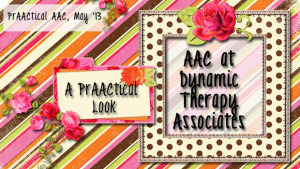
We’re so excited to continue our PrAACtical Look series with a guest post from Vicki Clarke, who is the CEO of Dynamic Therapy Associates, a speech language therapy clinic in Kennesaw, Georgia. Vicki specializes in AAC, conducting local and national device evaluations, consultations, treatments and trainings for individuals, clinics, school systems and professional organizations and manufacturers. Vicki has a wealth of knowledge in the prAACtical aspect of AAC service provision and shares a tiny bit of that with us in this post about preparing clients who use AAC for medical encounters. :::::::::::::::::::::::::::::::::::::::::::::::::::::::::::::::::::::::::::::::::::::::::::::::::::: I was asked to contribute a “favorite therapy activity” kind of post to this blog a few months ago. Decisions, decisions, decisions….I love Arts & Crafts Therapy, Cooking Therapy, iPad Therapy, Shopping Therapy, and Hang-Around-And-Chat Therapy but what to share? I mulled it over and I decided on “Serious Medical Procedure Preparation Therapy.” Fun stuff, right?!!? We do a lot... [Read More...]
Filed under: PrAACtical Thinking
Tagged With: device customization, Dynamic Therapy Associates, Medical, patient care, SGD programmming, Vicki Clarke
October 12, 2012
by Carole Zangari -
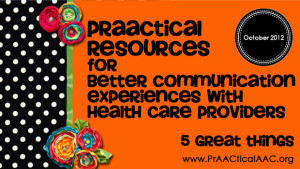
Being sick is no fun, but when you can’t communicate effectively with your healthcare provider, it can be disastrous. Here are some resources that SLPs can use to help promote effective communication and prevent adverse affects. Accommodations Cards: One of the simplest things we can do to help healthcare providers understand the needs of a person who uses AAC, is to give some basic information on an accommodations card. Health Bridges is a project of the Western Pennsylvania Initiative to support individuals who have hearing and vision loss. Their website includes a section that allows you to create quick accommodations cards for this population and serve as a good example for ones that you can make on your own. Accommodations cards don’t solve all the problems, but they’re a quick and easy way to make a start. Patient-Provider Communication Website: Amazing array of information and resources from around the world.... [Read More...]
Filed under: PrAACtical Thinking
Tagged With: communication, communication boards, doctor, healthcare, hospital, Medical, resources
September 14, 2012
by Carole Zangari -
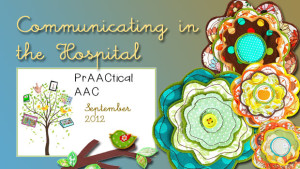
We are so happy to share a link to downloadable resources that come from the collaborative effort of the Patient Provider Communication Forum, Central Coast Children’s Foundation, Dr. Bronwyn Hemsley, and Widgit Software. These research-based materials were developed to help improve communication in hospital settings. The link takes you to the Widgit Health site and is a set of cards with 26 key phrases for patients who use picture symbols to communicate. The cards are printable and available in 20 different languages. You can access those materials here.
Filed under: PrAACtical Thinking
Tagged With: advocacy, communication boards, download, hospital, Medical, resources
June 25, 2012
by Carole Zangari -
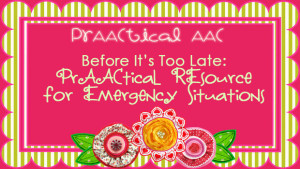
We’re in the first month of hurricane season and preparedness is very much on our minds. With that in mind, we thought it was a good idea to share a link to this important resource. The Royal Berkshire NHS Trust funded the development of this Communication Passport which is disseminated via the Widgit Symbol website. – This Communication Passport is designed to give important information about a person who uses AAC to healthcare professionals and first responders in case of accident or emergency. It uses a stoplight metaphor to guide the partner through important information, such as emergency contacts, health conditions, medications, how the person takes their medication, how to communicate with the person, and more. – Even those who are always accompanied by a familiar adult, such as a child, could benefit from this tool. In an emergency situation, there is often confusion and having all the key information... [Read More...]
Filed under: PrAACtical Thinking
Tagged With: Emergency, Medical, resources
April 26, 2012
by Carole Zangari -
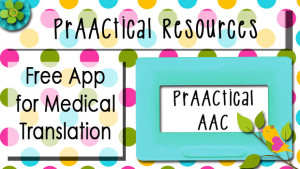
– Conversations with health care providers can be confusing, particularly when medical terminology comes into play. But what if you and your doctor literally speak different languages? Yup, there’s an app for that. – Medibabble is an app that translates thousands of medical questions and instructions into five different languages (English, Spanish, Cantonese, Mandarin, Russian, Haitian Creole). The Spanish language option is preinstalled and the rest are easy in-app downloads. The app itself and all the languages are free. – The main feature is a large database of questions, answers, and patient instructions that are organized by body systems (e.g., respiratory, digestive) and symptoms to allow medical staff to gather accurate case history information and convey information. There are also greetings/farewells, introductions (e.g., “I am your physical therapist), common responses (e.g., “Thank you for answering my questions”), and explanations (e.g., “Since an interpreter is not available immediately, this device will allow... [Read More...]
Filed under: PrAACtical Thinking
Tagged With: Apps, Medical, resources









